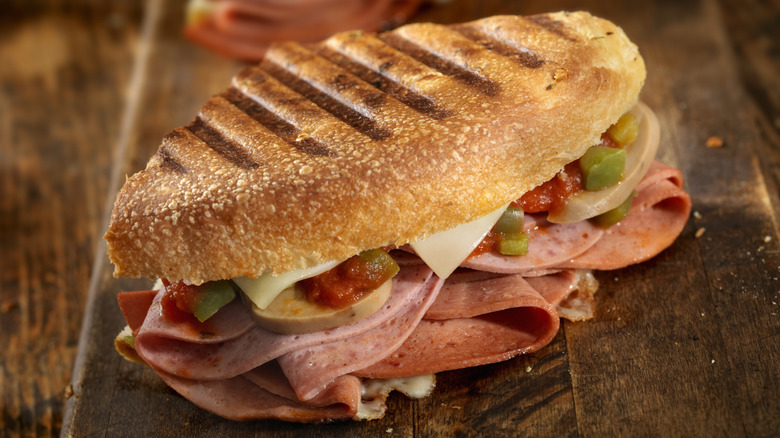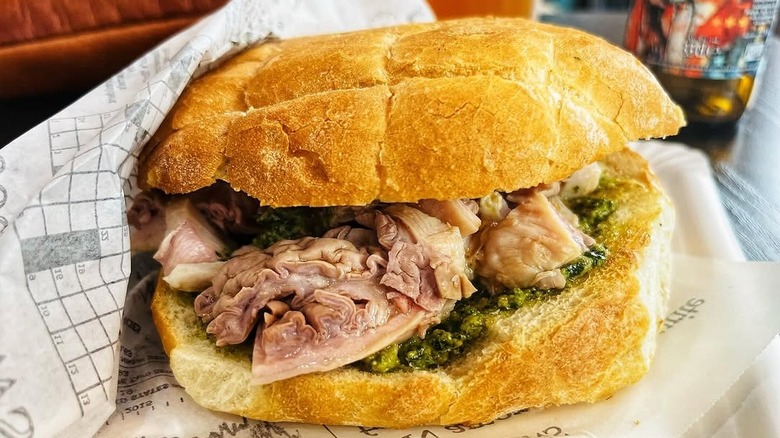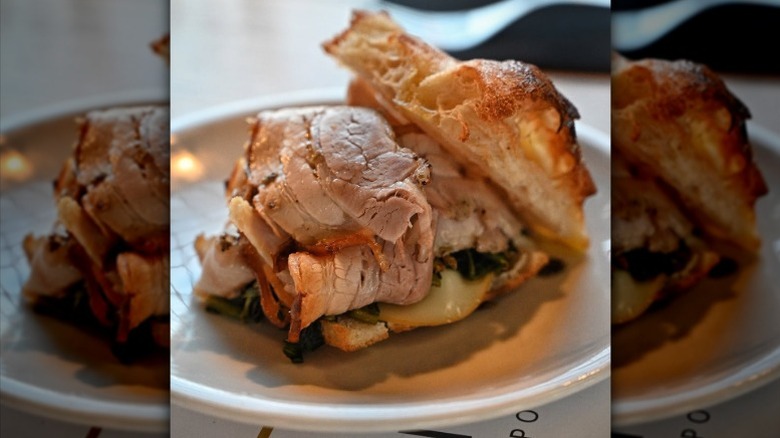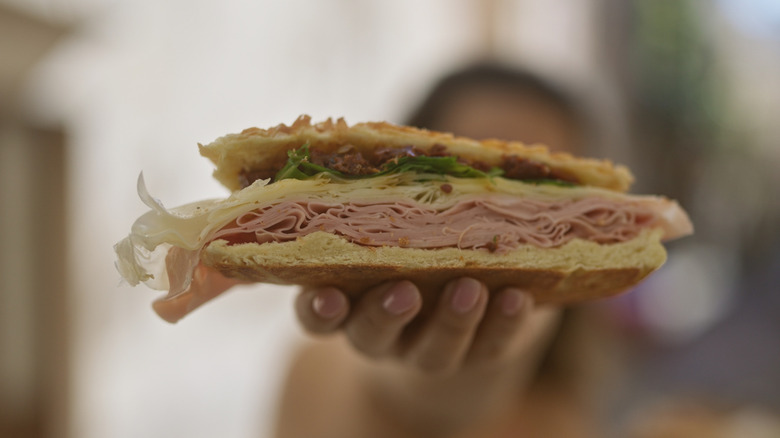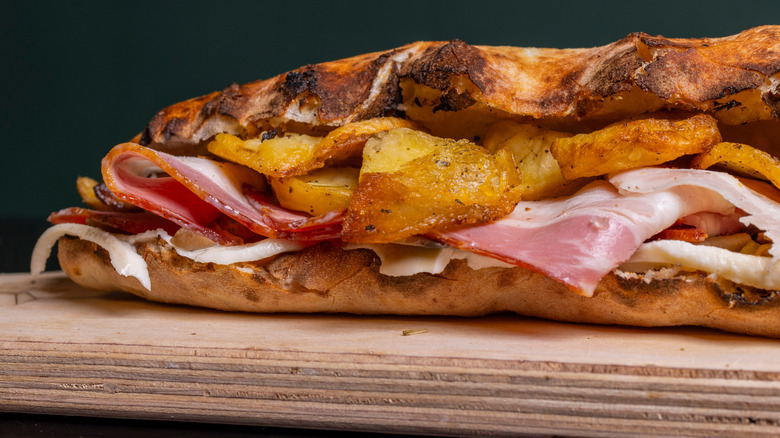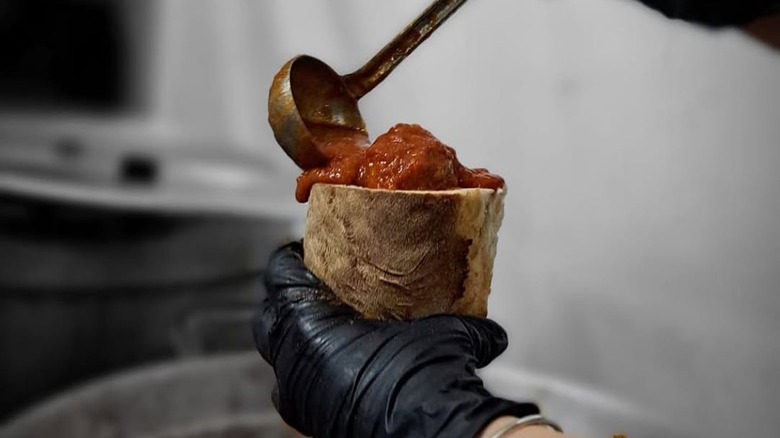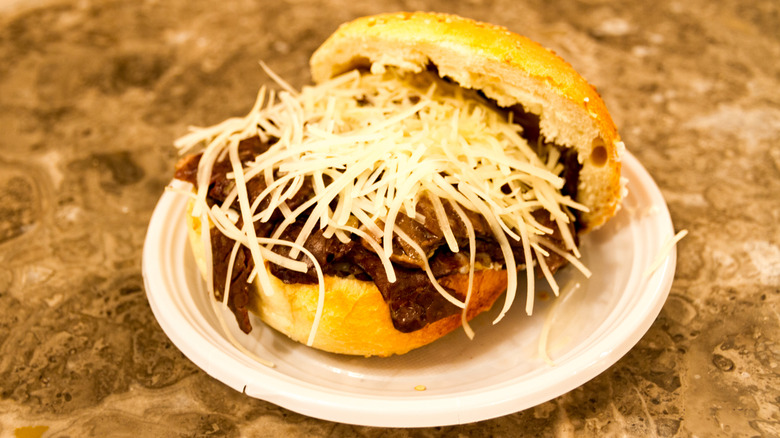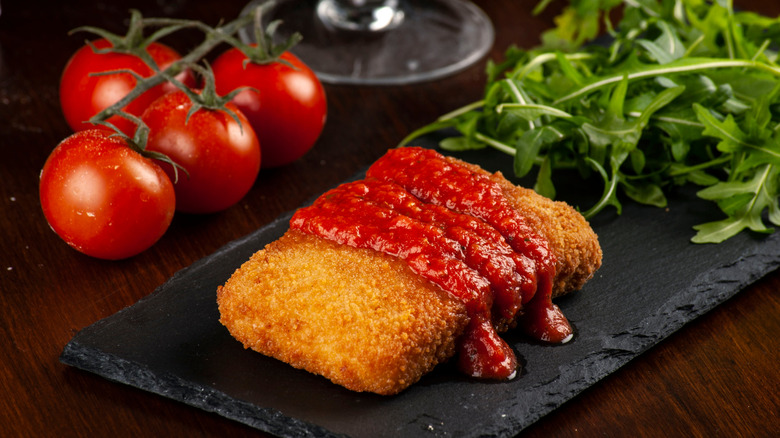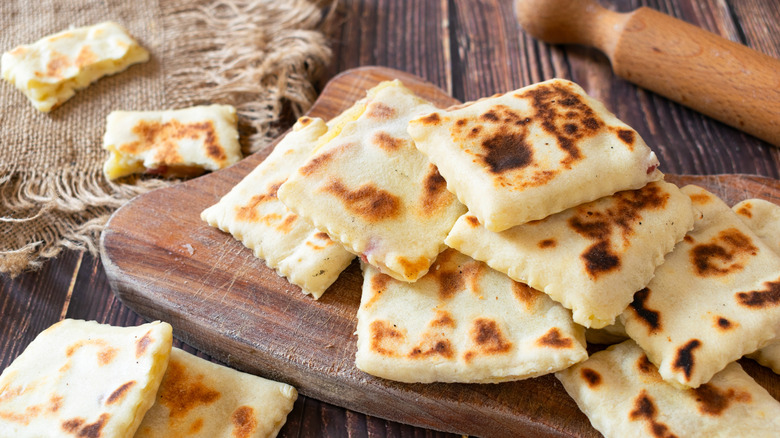11 Underrated Italian Sandwiches You Should Know About
Beyond pizza and pasta, Italy has a rich sandwich culture that often goes unnoticed in the United States, save for a few traditional Italian restaurants here and there. While most Americans are familiar with the most classic Italian dishes like pizza and pasta, the country's regional sandwich traditions offer a far more nuanced and diverse culinary landscape that can date back centuries.
The history and variety of Italian sandwiches are deeply intertwined with the country's social and economic development. Many of them originated as practical solutions for workers — farmers, laborers, and shepherds who needed substantial, easily transportable meals during long days of physical work. In regions like Puglia and Sicily, sandwiches became a way to transform local, often unassuming ingredients into satisfying and nutritious meals that could sustain workers through grueling workdays.
Today, however, sandwiches in Italy are more than just quick meals. They also reflect the local traditions and culture, where the creativity of cooks and street vendors turn simple ingredients into memorable dishes. From the narrow streets of Naples to the coastal towns of Sicily, these sandwiches showcase a deep respect for local ingredients and represent an approach to food that values tradition, technique, and practicality, too. The connection Italian sandwiches have to their specific locale is often what makes them famous in their own right. Here, we introduce eleven Italian sandwiches that deserve wider recognition, each a delicious window into Italy's rich culinary heritage and worth seeking out on your next Italian adventure.
Panino
The panino, often referred to as panini in the U.S., is a quintessential Italian sandwich that found its place in the hearts (and stomachs) of Italians in the mid-20th century— although its exact origins remain somewhat unclear. This classic creation, derived from Italy's long culinary history of bread and cured meats, became particularly popular as a quick, satisfying lunch in the busy cafes and bars of cities like Milan and Rome. By the 1970s and 1980s, the panino had crossed the Atlantic, making its mark in the U.S. as a trendy, yet simple meal option.
All over Italy, you'll see that paninos come in many varieties. They can range from a light, simple snack to a hearty meal, depending on the fillings and how it's prepared. Though each region adds its own twist, the basic components are universal: good-quality bread, such as ciabatta or focaccia; a selection of quality meats; and fresh, locally sourced ingredients. Still, they can range from a light, simple snack to a hearty meal, depending on the fillings and how it's prepared. The use of regional cured meats like prosciutto reflects Italy's deep-rooted tradition of charcuterie. When paired with cheeses like Fontina or Provolone and served on freshly grilled and pressed bread, the panino becomes a fully flavorful meal that captures the essence of Italian street food.
Panino con il lampredotto
The panino con il lampredotto is a quintessential Florentine street food that might challenge most American palates due to its strong flavor. Made from cow's stomach, this sandwich is an integral part of Florence's working-class culinary history. Dating back to the late 15th century during the Renaissance, it was originally a cheap, nutritious meal for the working class who needed an affordable and filling lunch.
Preparing lampredotto involves slowly simmering it with herbs and vegetables until it becomes tender. The meat is typically chopped and served in a soft roll, often accompanied by a spicy green Tuscan sauce that helps balance its distinctive flavor. While it might sound intimidating, locals consider it a delicacy that represents the city's nose-to-tail cooking tradition — nothing goes to waste.
This sandwich is more of a cultural institution in Florence than it is a simple dish. Street vendors have been selling lampredotto for generations, and you'll still find it at traditional food stalls throughout the city. For Florentines, the panino con il lampredotto isn't an adventurous eat whatsoever. Instead, it's a cherished local classic that connects them to their culinary heritage. Visitors willing to try it are gifted with a genuine taste of authentic Tuscan street food.
Porchetta di Ariccia
The small town of Ariccia, located in the Lazio region near Rome, is the most likely birthplace of one of Italy's most beloved sandwiches: Porchetta di Ariccia. The modern version of this pork sandwich is relatively new, dating back to only the 1950s. However, the tradition of porchetta itself can be traced back to ancient Roman times.
Preparing porchetta involves taking a whole, boneless pork — typically from a young pig — and seasoning it meticulously with a blend of herbs, such as garlic, rosemary, salt, and pepper. The meat is then slow-roasted for hours, allowing the skin to become perfectly crispy while the interior remains tender and juicy. When sliced and served in a fresh roll, it is a sandwich that captures the essence of Roman countryside cooking.
In Ariccia, porchetta is a cultural expression that has been formally recognized with Protected Geographical Indication (PGI) status, ensuring that the traditional preparation methods are preserved and celebrated. You can find it all over the country these days, too. In some places, it's considered a delicacy (not usually served in sandwich form, in this case). In others, like in Rome and the surrounding areas, it's served as everyday street food. Different regions have even developed their own versions of it. For example, in Umbria, the porchetta is stuffed with a mix of pig innards, lard, and seasonings.
Puccia
The puccia sandwich comes from southern Italy in Puglia's Salento region, where you'll find a culinary crossroads of Mediterranean flavors. It's not totally clear how the sandwich started, but it probably dates back to ancient Roman times when bread was a fundamental part of peasant life. Farmers needed a sturdy, easy-to-eat meal that could sustain them through long working days, giving birth to the puccia. Today, the sandwich has evolved from its unpretentious origins, thanks to its modernization in the 1970s. This transformation has led it to become a popular street food that attracts both locals and tourists eager to experience authentic cuisine from the area.
The bread itself is the staple of the sandwich. It's a round, thick loaf with a crispy exterior and soft interior that's hollowed out to create the perfect vessel for fillings. What's inside the sandwich can vary widely, often reflecting the season and local availability. For instance, you might find a puccia stuffed with fresh local cheeses, cured meats, ripe tomatoes, or even seafood caught that morning. In small towns across Salento, it's easy to find bakeries and street vendors each putting their own spin on this classic sandwich.
5 e 5
Pronounced "cinque-e-cinque" — that's how Italians say the number five — the name of the 5 e 5 sandwich is a reflection of its ingredients and their original cost. Hailing from Livorno in the Tuscan region of Italy, the 5 e 5 primarily contains a chickpea fritter and bread roll, which were each sold for five lire in the 1930s. What began as an affordable meal for laborers and students has become a mouthwatering piece of Tuscan economic history as well.
The star of the sandwich is the "torta di ceci," a chickpea pancake made from chickpea flour, water, olive oil, and salt. The batter is cooked on a large copper pan until it develops a golden, slightly crispy exterior. When served in a soft roll, it becomes a delicious and satisfying meal that speaks to the creativity of Tuscan street food. In Livorno's bustling markets and street corners, you'll still find vendors preparing these sandwiches using techniques passed down through generations, a delicious link to the city's past.
Panuozzo
The panuozzo, invented in the early 1980s by Giuseppe Mascolo in Gragnano, Italy, is a sandwich made from pizza dough. Mascolo wanted to craft an alternative to pizza, and after some experimentation, he perfected the panuozzo. He created it by baking pizza dough into a loaf, then slicing it open and stuffing it with ingredients like local cured meats, cheeses, and vegetables. Gragnano, a town near Naples known for its pasta production, became famous for this culinary invention, which Mascolo patented to protect its authenticity.
The preparation of the panuozzo requires patience and care. It begins with traditional pizza dough, shaped into a long oval and baked in a wood-fired oven until golden. The loaf is then split and filled with ingredients fillings before being briefly returned to the oven. This second bake melds the flavors and ensures the sandwich is served warm and crisp.
Originally only served at Pizzeria Mascolo, the panuozzo quickly gained popularity across Campania, becoming a staple of the region's street food. Countless variations are now available, ranging from classic recipes to modern twists. Despite its widespread appeal, purists argue that the most authentic experience can only be found at the original pizzeria in Gragnano. No matter the different forms it takes in the modern culinary scene, it remains a symbol of Gragnano's food heritage and a must-try dish for visitors to the region.
Cuzzetiello
The cuzzetiello is a quintessential Neapolitan street food made from the crusty end of cafone, a rustic regional bread. Traditionally, families would hollow out the bread and fill it with leftovers from Sunday meals, transforming humble scraps into a delicious and satisfying meal. This inventive use of leftovers showcases Naples' background of culinary creativity and resourcefulness.
This culinary tradition specifically speaks to Naples' "fare la scarpetta" culture, where diners use bread to soak up every last bit of sauce from their plates. Originally, the cuzzetiello was a clever way for working-class families to ensure nothing went to waste. The tough end of the bread, often too hard to enjoy on its own, became a delicious vessel for rich, slow-cooked ragù and tender meatballs, sometimes while it was still boiling in the pot.
Over time, the cuzzetiello has evolved from a practical leftover solution to a famous street food. While traditional versions still honor the original recipe of ragù and meatballs, modern interpretations have also emerged, using fillings like friarielli — broccoli rabe — and sausage, eggplant parmigiana, or creamy mozzarella with cured meats. Street vendors and small restaurants across Naples serve this sandwich regularly, allowing this sandwich to remain a living, breathing part of the city's gastronomic identity.
Tramezzino
The tramezzino emerged from Turin's vibrant café culture in 1926, created by Angela Demichelis Nebiolo at the Mulassano Café. More than just a sandwich, it represented a new approach to light, quick dining in Italy. Initially called paninetto, its name was reimagined as tramezzino when Gabriele D'Annunzio, a famed writer and frequent patron, commented that its triangular shape reminded him of the tramezze, or partition walls, at his estate. The name also symbolized its role as a snack in between traditional mealtimes.
Often compared to an Italian version of the tea sandwich, the tramezzino stands out for its use of crustless white bread, which was uncommon in Italy at the time. The soft bread replaced rustic Italian loaves, offering a smooth, delicate texture that perfectly complemented the refined fillings, such as butter and anchovies.
The versatility of the tramezzino — ranging from simple tuna or egg fillings to elaborate gourmet versions — cemented its role in Italian culinary culture. Today, this sophisticated sandwich remains a popular snack in many parts of Italy, often paired with aperitivo drinks like the negroni or spriz, demonstrating its continued connection to social and leisurely dining traditions.
Pani ca' meusa
Located on Sicily's northern coast, Palermo has long been a crossroads of Mediterranean cultures, with Arab, Norman, and Jewish influences shaping its identity. One of the city's most celebrated street foods, pani ca' meusa, is a testament to this rich cultural mix. This sandwich, made with fried veal spleen and lung, was first created in the late 19th century by Jewish butchers in Palermo who received animal organs and entrails organ as payment. They turned these less desirable cuts into a flavorful delicacy that didn't take long to became a local favorite.
This street food staple is prepared by carefully cleaning the organ meats, simmering them until tender, and then sautéing them in lard. The finished filling is served in a sesame bun, often topped with grated caciocavallo cheese, a squeeze of lemon, and a pinch of salt. Pani ca' meusa is commonly found in Palermo's bustling street markets, which are central to the city's food culture.
The flavors of pani ca' meusa are undeniably rich, thanks to the use of animal organs, so it's important to approach the sandwich with an open mind. If you're keen to try it, though, be prepared to visit Palermo, as this local favorite is hard to find outside the city.
Mozzarella en carrozza
Mozzarella en carrozza, literally meaning "mozzarella in a carriage," is an Italian comfort food with roots in the 19th century. The name playfully suggests that the mozzarella is being carried by the bread, which is a fun way to think about it. While its exact origins remain somewhat of a mystery, it is widely believed to have come from the Campania region of southern Italy. Initially, this dish was a practical, affordable way for working-class families to make use of leftover bread and cheese. Over time, it grew in popularity and became a staple across Italy, with many regional variations adapting the basic recipe. For example, in Venice you'll commonly find mozzarella en carrozza with anchovies or prosciutto.
The sandwich consists of fresh mozzarella, typically encased between slices of thick Italian bread, which is then dipped in egg and fried to crispy perfection. Though its humble beginnings are tied to frugality, mozzarella en carrozza has become a comforting dish enjoyed by people of all backgrounds in Italy and beyond. To find mozzarella en carrozza in the U.S., you'll want to visit an authentic Italian restaurant, one that goes beyond the usual pizza and pasta fare.
Piadina
The piadina, an unleavened flatbread, has a history stretching back to ancient Roman times. The version we recognize today began taking shape around the 14th century in the Emilia-Romagna region of northern Italy. During this time — especially in the aftermath of the plague around the year 1300 — the peasant class was unable to afford leavened bread. They returned to simpler foods like polenta, barley flour, and unleavened cakes made from less valuable cereals and legumes. This shift marked the origin of what would become the modern piadina, crafted from easily accessible ingredients such as wheat flour, water, salt, yeast, and a bit of lard. The dough is rolled thin and cooked on a griddle, creating the signature golden-brown spots.
In the early 20th century, the piadina experienced a great revival, largely thanks to the introduction of corn flour. Mixed with soft wheat flour, this new combination made the piadina even more affordable to produce while still maintaining the quality and flavor that made it a staple.
Today's piadina is typically filled with ingredients like soft cheeses, cold cuts, and fresh vegetables. It's far more than just a practical food now — it's a delicious treat that can be found in restaurants across Italy. In Emilia-Romagna, piadina is especially embedded in the region's street food culture, where both locals and visitors flock to it.

